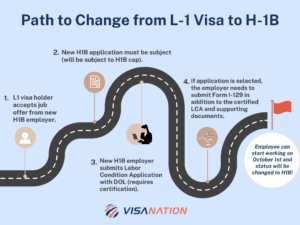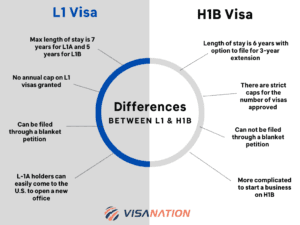L-1 to H-1B Change of Status | Process
Having an L-1 visa can be highly advantageous to you if you work for a multinational company. But there are many circumstances that may cause you to need to change your status from an L-1 visa to an H-1B visa. While there are some similarities between these two nonimmigrant work visas, there are also some key differences that may make one option much better than the other depending on your situation.
How to Change my L-1 Visa to an H-1B Visa
Transitioning from L-1 to H-1B change of status is not all that complicated. Once you find an employer to sponsor you on an H-1B visa, the process is relatively straightforward for an L-1 to H-1B change of status (COS). The important thing to remember is that there is no special process for changing your status from L-1 to H-1B. You will essentially be filing for an H-1B from scratch. The only difference will be that you are already in the U.S., so if your petition is approved, you may not need to go through a consular interview and can instead automatically change your status.
- L1 visa holder accepts the job offer from new H1B employer
- New H1B application must be subject (will be subject to H1B cap unless the new employer is an institution of higher education, non-profit that is associated with an institution of higher education or a governmental research center). If possible, its good to get a job offer from an employer that falls into one of these categories because your petition will not be subject to the cap
- New H1B employer submits Labor Condition Application with DOL (requires certification)
- In the event that the application is chosen in the lottery, the employer petitioning you needs to submit Form I-129 in addition to the certified Labor Condition Application and supporting documents
- Assuming the H1B visa petition gets approved, you (the employee) can start working on October 1st and your status will be changed.
What if my employer is outside of the country?
If that’s the case, you will receive status via consular processing which requires getting a visa stamp.
What if my petition is denied?
If you were not chosen in the H1B lottery, rest assured that your L1 visa will still be valid assuming you can continue working for your prior employer. Discuss this with your immigration attorney to make sure there are no loose ends.
L-1 Background
The L-1 is a temporary work visa that is meant for the transfer of employees from a multinational company’s foreign branch to a location in the U.S. There are two types of L-1 visas, both of which may be suitable for a change of status to an H-1B. The L-1A is for executives and managers of this company while the L-1B is for employees with specialized knowledge.
H-1B Background
The H-1B, on the other hand, is not limited to multinational companies, which is what makes it such a popular visa option. Anyone with a bachelor’s degree and a job offer from a U.S. company for a specialty position can apply. For this reason, as we’ll go over later, the H-1B has a numerical limit on the number of visas issued annually. Those that go onto processing are chosen through a random lottery, which makes getting an H-1B largely up to chance.
Also, the terms “specialized knowledge” for the L-1B and “specialty position” for the H-1B are not synonymous. Specialized knowledge refers to having knowledge that is specific to that multinational company while a specialty position is one that requires a bachelor’s degree to perform (usually one in the STEM categories).
To begin with, there are a few similarities between L-1 and H-1B status:
- Both L-1 and H-1B are temporary (non-immigrant) visas that allow dual intent. In this case, dual intent means that the foreign worker does not need to demonstrate ties to the home country or jeopardize their visa status by filing for a green card.
- They both are available for premium processing. The premium processing fee of $2,500 and checks should be made payable to the U.S. Department of Homeland Security. USCIS guarantees that premium processing cases will be handled within 15 calendar days. If you receive a request for evidence (RFE) or other additional paperwork then an additional 15-day period will begin for processing once USCIS receives those documents.
- The spouse of an L-1 visa holder may apply for Employment Authorization Documents (EADs) and subsequently start working legally after receiving approval. Relatives of H visa holders can also be eligible to get an EAD if their spouse is the principal beneficiary of an approved Form I-140, Immigrant Petition for Alien Worker.
What are my chances of getting selected in the H1B lottery?
All petitions submitted while the window is open have the same chance. If you have the necessary qualifications, however, the Masters Quota is better because it sets aside an additional 20,000 petitions. You may qualify for the master’s cap if you received your degree from a U.S. based institution that is public or non-profit in nature and has been recognized by a national accrediting agency as being accredited
VisaNation Law Group H1B Fee
We charge a flat H-1B visa attorney fee of $2,400, which includes shipping and incidentals but does not include RFE responses, if applicable. In addition, you are responsible for the USCIS filing fees associated with your case. You can see other H1B Related Fees here.
Likewise, there are key differences between the two visas:
- The maximum length an individual can remain in the U.S. on an L-1 is seven years (L-1A) and five years for L-1B. Whereas an H-1B status holder can stay for six years with the option to file for a three-year extension.
- For individuals who spend time outside the country on an H visa, that duration is applied towards the maximum amount of the L visa (or vice versa).
- There is no annual cap on the number of L-1 visas granted and it does not require any specific educational degree. Moreover, employers are not required to submit a labor condition application. Within the H-1B category, there are exemptions to the cap for those who meet specific criteria. Click here to learn about the H-1B cap exempt requirements.
- L-1 visa petitions can also be filed en masse through a blanket petition. This allows employers to file one petition for multiple employees simultaneously. The H-1B has no such option.
- L-1A holders can easily come to the U.S. to open a new office (though visas in this case are issued for an initial period of one year). Although it is possible to start a business on an H-1B visa, it is more complicated and there are no special provisions for it.
- H-1B recipients are required to have some “specialized knowledge” related to the position and possess at minimum a bachelor’s degree (or equivalent). Although in some cases, work experience may substitute the formal degree.
Advantages of L-1 to H-1B Change of Status
- The process is relatively simple compared to other changes of status and if you happen to be denied for H-1B status, you can remain in the country on your L-1 visa!
- Foreign workers on L-1 status are not allowed to apply for a job other than the one in which they were approved on their application. This means they also can’t transfer their L-1 visa to a different company. So by changing to H-1B visa status the foreign worker is able to change employers/jobs at any given point.
- Once approved for H-1B status, you can begin working as soon as October rolls around.
Disadvantages of L-1 to H-1B Change of Status
- As a worker on H-1B status, you are required to pay taxes on the wage rate determined by the Labor Department whereas L-1 status does not dictate a minimum wage rate.
- There are a limited number of H-1B visas available each year whereas L-1 visas are not subject to numerical limits. To get an H-1B visa, you need to go through a lottery that can severely reduce your odds of successfully changing your status.
There may be additional disadvantages of L-1 to H-1B change of status for your particular situation. Since this is subjective, it’s best to consult an immigration attorney.
L-1 to H-1B Cap Exempt
As you can see, one of the major disadvantages of the H-1B among all other nonimmigrant visas is the fact that it is subject to the annual cap and lottery. However, not all H-1B petitions fall under this cap. H-1B transfers and extensions are cap-exempt, and so are petitions filed for certain cap-exempt employers. This last part is important if you are an L-1 visa holder who wants to avoid the cap.
There are three types of employers that are not subject to the cap:
- Institutions of higher education
- Non-profit organizations that are associated with institutions of higher education, and;
- Governmental research centers
If you can get a job offer from an employer that falls into one of these categories, your petition will not be subject to the cap. This means that it can be submitted at any time (not just the first business day in April like cap-subject petitions) and you do not have to wait until October 1st to begin working as an H-1B employee.
However, this is not an effective way to circumvent the cap and work for a different employer. If you file to transfer your H-1B status from a cap-exempt employer to a cap-subject one, you will need to enter your petition into the lottery and be restricted to the designated time period.
Process of L-1 to H-1B Change of Status
The H-1B season begins the first business day in April and in past years, it has been structured as a lottery system. Every cap-subject H-1B petition that is submitted to the USCIS will receive an identifier number which is then categorized into the Masters Quota or the Regular Quota. In prior seasons the regular quota was 65,000 while the Masters Quota was 20,000. Although the official season isn’t expected until April, it’s important to begin planning as soon as possible because unless you were on H-1B status in the past, you’re subject to the annual cap.
The H-1B sponsoring employer or company will file the petition on your behalf. The employment letter should include:
- Details regarding the duties and responsibilities of the position
- Specific dates of employment
- An indication of the prevailing wage in relation to the actual wage. H-1B employers are required to pay the employee the higher amount. Prevailing wages are established by the State Employment Security Agency based on the worker’s duties, experience and skills necessary to complete the job.
The next step is to file a Labor Certification Application regarding the H-1B sponsor. This entails having your employer make four attestations to the Department of Labor.
- That you will be paid the prevailing wage for your job and geographic location
- That your employment will not negatively affect the working conditions of those currently employed with your employer.
- That the current employees have been notified of the intent to hire you.
- That no strike or lockout is taking place.
Once approved, the DOL will return the employer a certified copy. Finally, all the necessary documents (including Form I-129, experience and employment agreements) should be sent to the appropriate USCIS service center. You should also make sure that the fees are correct. Here are the fees that go along with a first-time H-1B visa:
- I-129 filing fee – $460
- Fraud prevention fee – $500
- ACWIA fee – $750 if your employer has fewer than 26 employees and $1,500 for 26 or more.
- Public law 114-113 fee – $4,000. This fee is only applicable if your employer has more than 50 employees with at least half of them on H-1B or L-1 status.
Remember that your employer is responsible for all of these fees. By law, the beneficiary is not permitted to pay them. However, you can pay the premium processing fee, though you will need to indicate that the reason is due to your personal gain and not the gain of the employer.
If your petition is selected in the lottery and subsequently approved, you will be able to start working as an H-1B employee on October 1st of the same year that you filed. On that day, your nonimmigrant status will automatically change to H-1B.
Can You Change Your L-1 to H-1B With the Same Employer?
As long as your L-1 employer can be considered a U.S. employer and can offer you a specialized position, you should be able to have that employer sponsor you for an H-1B. However, keep in mind that an employer with too many H-1B workers may be considered H-1B dependent. Also, remember that you need a bachelor’s degree that is related to your specialized H-1B job. Not all L-1 positions qualify you for an H-1B. Be sure to have your immigration attorney review your case and determine whether or not your position qualifies.
Additional Tips to Ensure Approval
- Complete all forms in black ink
- Double-check the amount on the checks or money orders and the mailing address
- Be conscious of deadlines and begin planning as early as possible
- Consult with the VisaNation Law Group to review all your documentation
Once you receive a petition approval, you are set for an L-1 to H-1B change of status (COS) and can begin working for the new employer beginning October of that year. If you receive a denial, then, in theory, you would continue working for your original employer on L-1 status.







